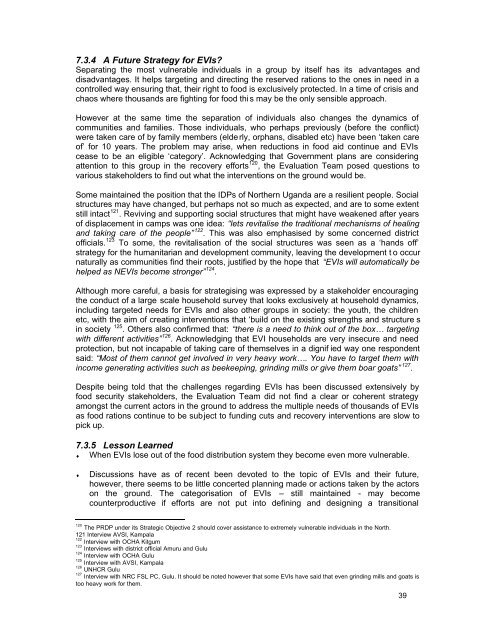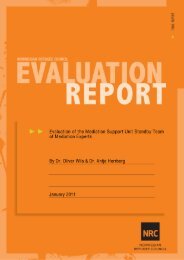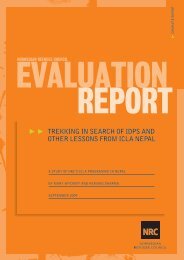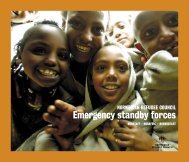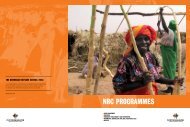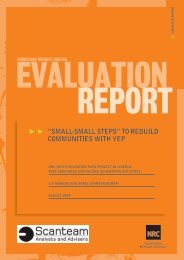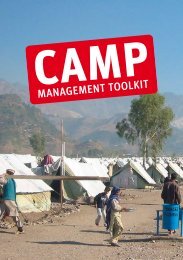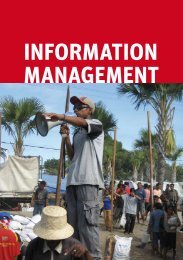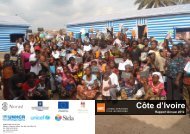evaluation of general food distribution in northern uganda: gulu ...
evaluation of general food distribution in northern uganda: gulu ...
evaluation of general food distribution in northern uganda: gulu ...
You also want an ePaper? Increase the reach of your titles
YUMPU automatically turns print PDFs into web optimized ePapers that Google loves.
7.3.4 A Future Strategy for EVIs?Separat<strong>in</strong>g the most vulnerable <strong>in</strong>dividuals <strong>in</strong> a group by itself has its advantages anddisadvantages. It helps target<strong>in</strong>g and direct<strong>in</strong>g the reserved rations to the ones <strong>in</strong> need <strong>in</strong> acontrolled way ensur<strong>in</strong>g that, their right to <strong>food</strong> is exclusively protected. In a time <strong>of</strong> crisis andchaos where thousands are fight<strong>in</strong>g for <strong>food</strong> this may be the only sensible approach.However at the same time the separation <strong>of</strong> <strong>in</strong>dividuals also changes the dynamics <strong>of</strong>communities and families. Those <strong>in</strong>dividuals, who perhaps previously (before the conflict)were taken care <strong>of</strong> by family members (elderly, orphans, disabled etc) have been ‘taken care<strong>of</strong>’ for 10 years. The problem may arise, when reductions <strong>in</strong> <strong>food</strong> aid cont<strong>in</strong>ue and EVIscease to be an eligible ‘category’. Acknowledg<strong>in</strong>g that Government plans are consider<strong>in</strong>gattention to this group <strong>in</strong> the recovery efforts 120 , the Evaluation Team posed questions tovarious stakeholders to f<strong>in</strong>d out what the <strong>in</strong>terventions on the ground would be.Some ma<strong>in</strong>ta<strong>in</strong>ed the position that the IDPs <strong>of</strong> Northern Uganda are a resilient people. Socialstructures may have changed, but perhaps not so much as expected, and are to some extentstill <strong>in</strong>tact 121 . Reviv<strong>in</strong>g and support<strong>in</strong>g social structures that might have weakened after years<strong>of</strong> displacement <strong>in</strong> camps was one idea: “lets revitalise the traditional mechanisms <strong>of</strong> heal<strong>in</strong>gand tak<strong>in</strong>g care <strong>of</strong> the people” 122 . This was also emphasised by some concerned district<strong>of</strong>ficials. 123 To some, the revitalisation <strong>of</strong> the social structures was seen as a ‘hands <strong>of</strong>f’strategy for the humanitarian and development community, leav<strong>in</strong>g the development t o occurnaturally as communities f<strong>in</strong>d their roots, justified by the hope that “EVIs will automatically behelped as NEVIs become stronger” 124 .Although more careful, a basis for strategis<strong>in</strong>g was expressed by a stakeholder encourag<strong>in</strong>gthe conduct <strong>of</strong> a large scale household survey that looks exclusively at household dynamics,<strong>in</strong>clud<strong>in</strong>g targeted needs for EVIs and also other groups <strong>in</strong> society: the youth, the childrenetc, with the aim <strong>of</strong> creat<strong>in</strong>g <strong>in</strong>terventions that ‘build on the exist<strong>in</strong>g strengths and structure s<strong>in</strong> society 125 . Others also confirmed that: “there is a need to th<strong>in</strong>k out <strong>of</strong> the box… target<strong>in</strong>gwith different activities” 126 . Acknowledg<strong>in</strong>g that EVI households are very <strong>in</strong>secure and needprotection, but not <strong>in</strong>capable <strong>of</strong> tak<strong>in</strong>g care <strong>of</strong> themselves <strong>in</strong> a dignif ied way one respondentsaid: “Most <strong>of</strong> them cannot get <strong>in</strong>volved <strong>in</strong> very heavy work…. You have to target them with<strong>in</strong>come generat<strong>in</strong>g activities such as beekeep<strong>in</strong>g, gr<strong>in</strong>d<strong>in</strong>g mills or give them boar goats” 127 .Despite be<strong>in</strong>g told that the challenges regard<strong>in</strong>g EVIs has been discussed extensively by<strong>food</strong> security stakeholders, the Evaluation Team did not f<strong>in</strong>d a clear or coherent strategyamongst the current actors <strong>in</strong> the ground to address the multiple needs <strong>of</strong> thousands <strong>of</strong> EVIsas <strong>food</strong> rations cont<strong>in</strong>ue to be subject to fund<strong>in</strong>g cuts and recovery <strong>in</strong>terventions are slow topick up.7.3.5 Lesson Learned♦ When EVIs lose out <strong>of</strong> the <strong>food</strong> <strong>distribution</strong> system they become even more vulnerable.♦Discussions have as <strong>of</strong> recent been devoted to the topic <strong>of</strong> EVIs and their future,however, there seems to be little concerted plann<strong>in</strong>g made or actions taken by the actorson the ground. The categorisation <strong>of</strong> EVIs – still ma<strong>in</strong>ta<strong>in</strong>ed - may becomecounterproductive if efforts are not put <strong>in</strong>to def<strong>in</strong><strong>in</strong>g and design<strong>in</strong>g a transitional120The PRDP under its Strategic Objective 2 should cover assistance to extremely vulnerable <strong>in</strong>dividuals <strong>in</strong> the North.121 Interview AVSI, Kampala122Interview with OCHA Kitgum123Interviews with district <strong>of</strong>ficial Amuru and Gulu124Interview with OCHA Gulu125Interview with AVSI, Kampala126UNHCR Gulu127Interview with NRC FSL PC, Gulu. It should be noted however that some EVIs have said that even gr<strong>in</strong>d<strong>in</strong>g mills and goats istoo heavy work for them.39


